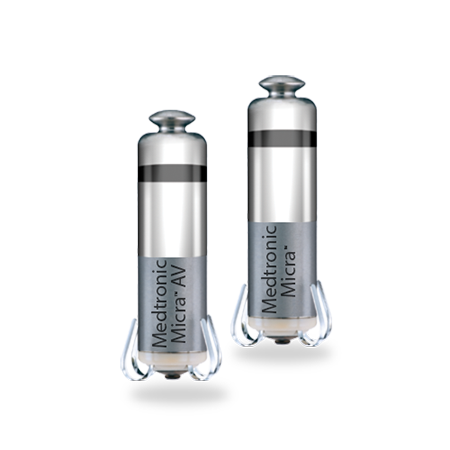From Niche to Mainstream
Clinicians recently performed the 100,000th procedure implanting Micra™, the world’s smallest pacemaker1
When Medtronic unveiled the Micra™ Transcatheter Pacing System (TPS) to the world in 2013, some cardiac electrophysiologists were skeptical. How could a pacemaker the size of a vitamin and implanted directly into the heart deliver effective pacing therapy? And how could it be done without leads, the insulated wires used to detect electrical activity in the heart and transmit potentially life-saving electrical impulses?
Dr. Robert Kowal was eager to find out.
“Micra took everything that we knew about pacing and made us rethink it,” said Kowal, a cardiac electrophysiologist who was implanting pacemakers at Baylor Heart and Vascular Hospital in Texas when Micra received FDA approval in 2016. “For me, that was really exciting.”

Since then, Micra™ has established itself as a proven technology in the quickly evolving world of cardiac pacing. In fact, Medtronic recently celebrated the 100,000th implant of Micra™, the world’s smallest pacemaker.
Shown to have 63% fewer major complications than traditional pacemakers2, Micra™ launched an entire family of leadless pacemakers, the first and only portfolio of leadless pacemakers to ever receive FDA approval.
“Medtronic was launched decades ago with the invention of the battery-powered, wearable pacemaker,” said Medtronic Chairman and CEO Geoff Martha. “With Micra, we continue to revolutionize cardiac pacing technology and disrupt the market on which the company was founded. This milestone builds on our relentless pursuit of better outcomes and experiences for patients.”
Reinventing the pacemaker
A traditional pacemaker includes a silver-dollar-sized pulse generator implanted in a “pocket” of tissue near the shoulder, with one or more leads strung through the blood vessels and attached permanently to the inner surface of the heart.
Micra™ is not that kind of pacemaker.
In 2009, Medtronic began its full-time quest to develop a leadless pacemaker in hopes of creating a device that would be safer for the patient, easier for physicians to use, and eliminate some of the potential complications that come with surgery. Advances in miniaturization and battery technology spurred development, allowing engineers to build a device that was about one-tenth the size of a traditional pacemaker at that time.
Dr. Kowal, who is now the chief medical officer of Cardiac Rhythm Management at Medtronic, recalls seeing some early designs.
“Those early models reminded me of fishing weights,” he said. “They were about the same size”
The size of Micra™ allows it to be inserted directly into the heart via a catheter during a minimally invasive procedure. As a result of the implantation technique, there is no bump on the chest under the skin.
“I remember asking one patient who was implanted with Micra how it felt and he said and he remarked with excitement, ‘I feel nothing. I can’t tell it’s even there. I don’t feel dizzy anymore,’” Kowal said. “That’s very different from a patient who has physical scar. For some people, it’s a constant reminder that they might not live as independently as they once did.”
The future is even smaller

Micra served as a launching pad for the development of the next generation of leadless pacemakers. That includes the recently introduced Micra AV™.
Approved by the FDA in 2020, Micra AV™ looks like the original Micra. However, Micra AV™ has several additional and quite novel internal atrial sensing algorithms which detect cardiac movement, allowing the device to adjust pacing in the ventricle to coordinate with the atrium, providing “AV synchronous” pacing therapy.
Micra AV™ is indicated for the treatment of patients with AV block, a condition in which the electrical signals between the chambers of the heart (the atria and the ventricle) are impaired.
With the approval of Micra AV™, nearly 50 percent of all pacemaker patients are now potential candidates for a leadless device.
Clearly, innovation never stops at Medtronic.
“With the 100,00th Micra procedure, I think we can safely say this device has gone from niche to mainstream,” Kowal said.
For more information about this important milestone, please watch this video.
Important Safety Information
Indications (or Intended Use)
Micra devices, Micra Model MC1VR01 and Micra AV Model MC1AVR1, are indicated for use in patients who have experienced one or more of the following conditions:
• Paroxysmal or permanent high-grade AV block in the presence of AF
• Paroxysmal or permanent high-grade AV block in the absence of AF, as an alternative to dual chamber pacing, when a dual-chamber transvenous pacing system is considered difficult, high risk, or not deemed necessary for effective therapy
• Symptomatic bradycardia-tachycardia syndrome or sinus node dysfunction (sinus bradycardia or sinus pauses), as an alternative to atrial or dual chamber pacing, when a dual-chamber transvenous pacing system is considered difficult, high risk, or not deemed necessary for effective therapy
Micra AV Model MC1AVR1 is also indicated for VDD pacing in patients with adequate sinus rates who may benefit from maintenance of AV synchrony. The Micra AV device provides AV synchronous ventricular pacing similar to a transvenous VDD system. The implanted device depends on the appropriate sensing of atrial mechanical signals to achieve AV synchrony. The level of AV synchrony may vary in individual patients and may not be predictable prior to implant.
Rate-responsive pacing is indicated to provide increased heart rate appropriate to increasing levels of activity.
The device is designed to be used only in the right ventricle.
Contraindications
Micra Model MC1VR01 and Micra AV Model MC1AVR1 are contraindicated for patients who have the following types of medical devices implanted: an implanted device that would interfere with the implant of the Micra device in the judgment of the implanting physician, an implanted inferior vena cava filter, a mechanical tricuspid valve, or an implanted cardiac device providing active cardiac therapy that may interfere with the sensing performance of the Micra device.
The device is contraindicated for patients who have the following conditions: femoral venous anatomy unable to accommodate a 7.8 mm (23 French) introducer sheath or implant on the right side of the heart (for example, due to obstructions or severe tortuosity), morbid obesity that prevents the implanted device from obtaining telemetry communication within ≤12.5 cm (4.9 in), or known intolerance to the materials listed in the Instruction for Use, or to heparin, or sensitivity to contrast media that cannot be adequately premedicated, or if the steroid dose from this device cannot be tolerated.
Warnings and Precautions
End of Service (EOS) – When the EOS condition is met, the clinician has the option of permanently programming the device to Off and leaving it in the heart, or retrieving the device, provided the device has not yet become encapsulated. Removal of the Micra device after it has become encapsulated may be difficult because of the development of fibrotic tissue. If removal of the device is required, it is recommended that the removal be performed by a clinician who has expertise in the removal of implanted leads.
MRI conditions for use – Before an MRI scan is performed on a patient implanted with the Micra device, the cardiology and radiology professionals involved in this procedure must understand the requirements specific to their tasks as defined in the device manuals.
Rate-responsive mode may not be appropriate for patients who cannot tolerate pacing rates above the programmed Lower Rate. For Micra Model MC1VR01, asynchronous VVIR pacing with sinus rhythm may not be appropriate when competitive pacing is considered undesirable or causes symptoms of pacemaker syndrome. The patient’s age and medical condition should be considered by physicians and patients as they select the pacing system, mode of operation, and implant technique best suited to the individual.
Precautions should be taken before administering anticoagulant agents, antiplatelet agents, or contrast media in patients with known hypersensitivity to these agents.
The use of deactivated Micra devices in situ and an active Micra device, or an active transvenous pacemaker or defibrillator, has not been clinically tested to determine whether EMI or physical interaction is clinically significant. Bench testing supports that implantation of an active Micra device, or an active transvenous pacemaker or defibrillator, next to an inactivated Micra device is unlikely to cause EMI or physical interaction. Post-approval studies are planned to characterize risks of co-implanted, deactivated Micra devices. Currently recommended end of device life care for a Micra device may include the addition of a replacement device with or without explanation of the Micra device, which should be turned off.
For Micra AV Model MC1AVR1, patient activities and environments which present mechanical vibrations to the patient can interfere with the mechanical sensing of atrial contractions. This can result in a loss of AV synchrony.
Potential Adverse Events or Potential Complications
Potential complications include, but are not limited to, toxic/allergic reaction, oversensing, pacemaker syndrome, cardiac arrest, acceleration of tachycardia, necrosis, myocardial infarction and surgical complications such as cardiac perforation, pericardial effusion, cardiac tamponade, device embolization, hematoma, AV fistula, vessel dissection, infection, cardiac inflammation, and thrombosis.
See the device manuals for detailed information regarding the implant procedure, indications, contraindications, warnings, precautions, MRI conditions for use, and potential complications/adverse events. For further information, please call Medtronic at 1-800-328-2518 and/or consult Medtronic’s website at www.medtronic.com.
Caution: Federal law (USA) restricts these devices to sale by or on the order of a physician.
1 Nippoldt D, Whiting J. Micra Transcatheter Pacing System Device Volume Characterization Comparison. November 2014. Medtronic data on file.
2 4 El-Chami MF, Al-Samadi F, Clementy N, et al. Updated performance of the Micra transcatheter pacemaker in the real-world setting: A comparison to the investigational study and a transvenous historical control. Heart Rhythm. December 2018;15(12):1800-1807
Clinical and Economic Evidence Driving Patient-Centered Care
Read How: Meaningful Innovation
L001-07152021
